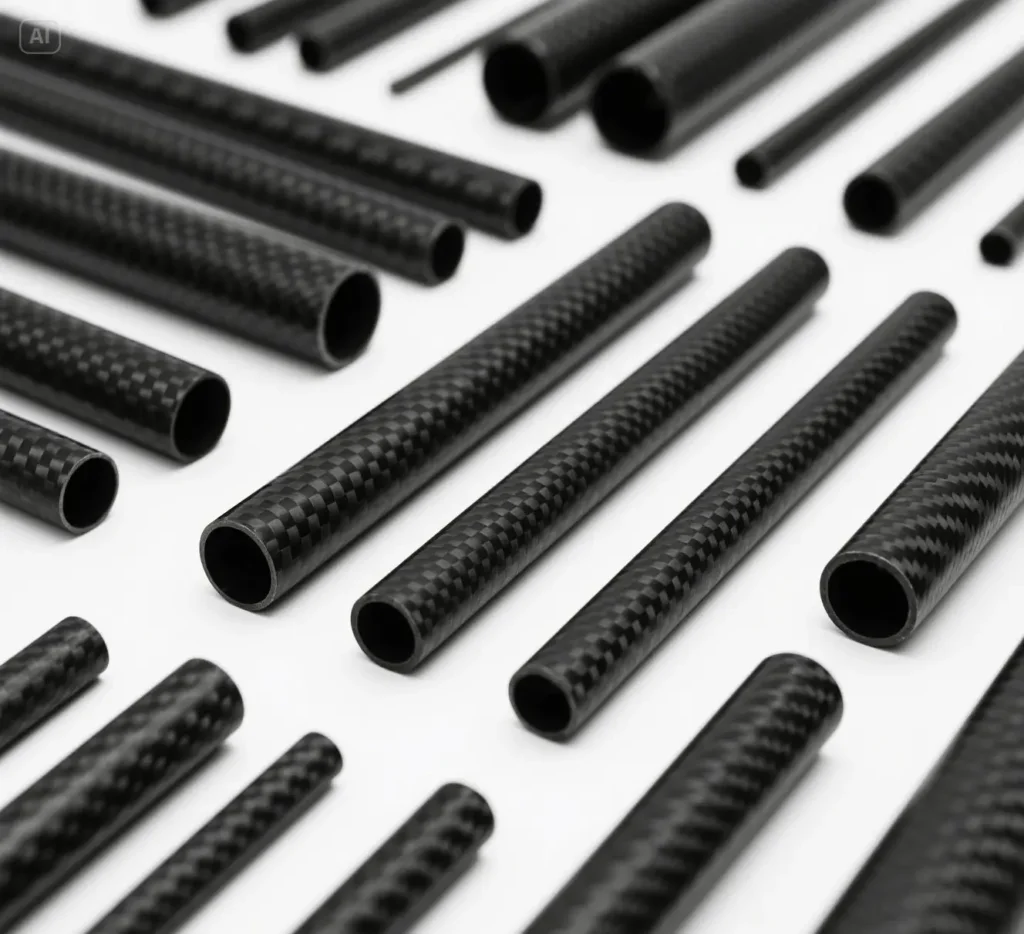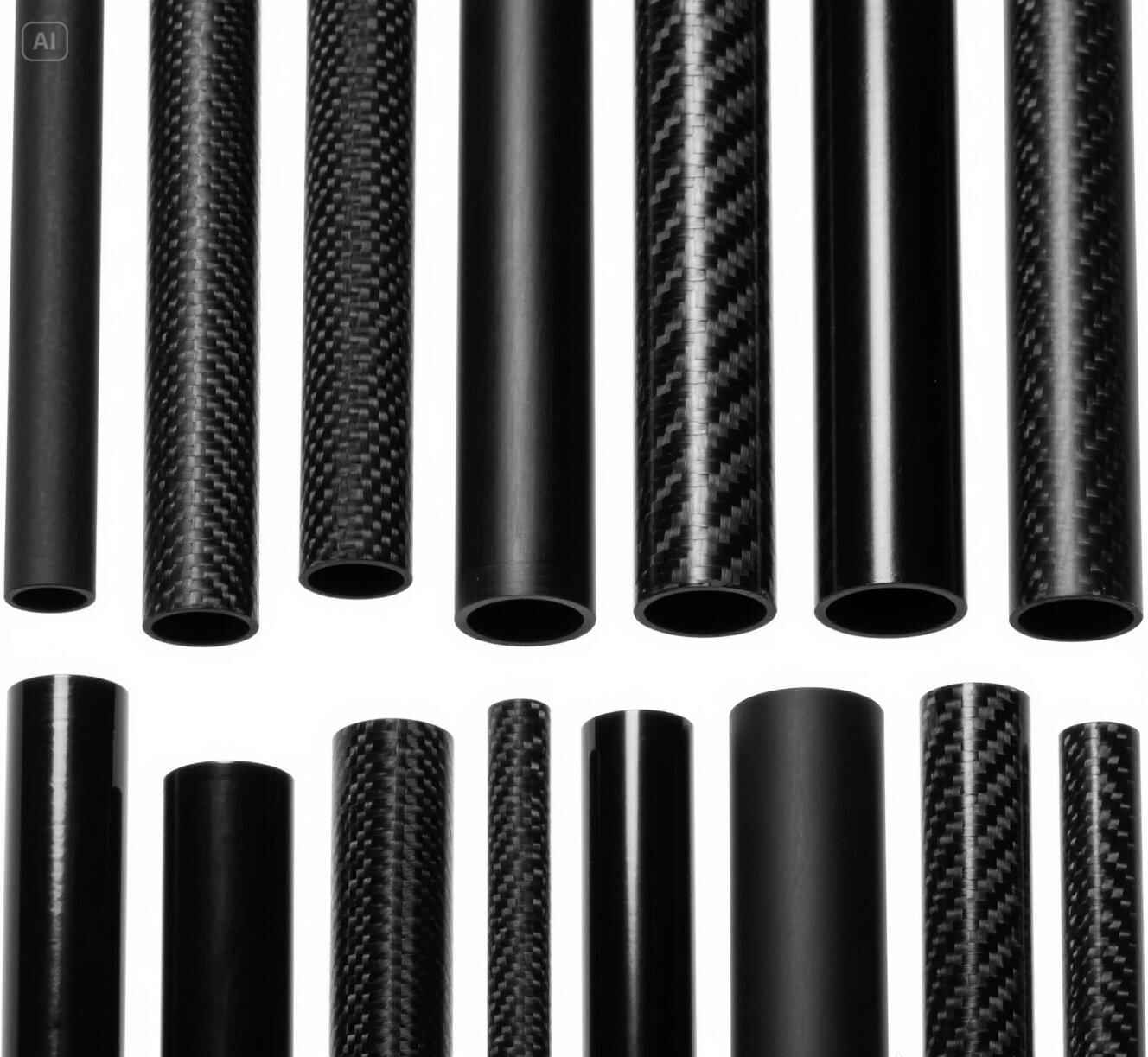
Углеродное волокно - материал, который раньше использовался только в аэрокосмической промышленности и высокопроизводительных гонках, теперь находит свое применение во многих отраслях. Исключительное соотношение прочности и веса и долговечность обеспечивают неоспоримые преимущества. Однако многие покупатели считают, что навигация в области углеволоконной техники несколько озадачивает. Цель этой статьи - разъяснить, что такое соединители для трубок из углеродного волокна и композитные платы. Мы рассмотрим решения с вашей точки зрения. Понимание этих компонентов может открыть новые возможности дизайна и производительности для ваших проектов.
Поразительные преимущества трубок из углеродного волокна в строительстве и промышленности
Коннектор для трубки из углеродного волокна произведет революцию в подходе к решению структурных задач. Представьте себе материал, который значительно легче стали и при этом обладает сопоставимой или даже превосходящей прочностью. Уже одно это свойство открывает возможности для инноваций в строительстве и различных отраслях промышленности. Например, более легкие компоненты означают снижение логистических затрат. Кроме того, более легкая обработка при сборке напрямую означает экономию времени и труда.
Ссылки:
1. Как резать трубки из углеродного волокна: Ключ к допуску и отношениям с клиентами
2.Как мы помогли нашему клиенту решить проблемы с продукцией с помощью наших трубок из углеродного волокна?
3.Можно ли массово производить трубки из углеродного волокна? Вот что вам нужно знать
4.Как улучшить качество поверхности углепластиковых труб большого диаметра
5.Телескопические трубки из углеродного волокна: Дорогая реклама или скачок в производительности?
Рассмотрим строительный проект, требующий длинных пролетов или деликатного размещения. A соединитель для трубок из углеродного волокна значительно упрощает подобные задачи. Присущая ему жесткость предотвращает провисание или деформацию под нагрузкой. Кроме того, углеродное волокно демонстрирует отличную устойчивость к воздействию факторов окружающей среды. В отличие от металлов он не подвержен коррозии. Это означает, что конструкции, построенные с использованием компонентов из углеродного волокна, требуют меньше технического обслуживания в течение всего срока службы, что в долгосрочной перспективе приводит к экономии средств для заказчика. От робототехники, где важен каждый грамм, до морских приложений, где коррозия представляет собой постоянную борьбу, - все это приносит огромную пользу. Подумайте о труба крыла из углеродного волокна для беспилотного летательного аппарата или квадрокоптер с трубкой из углеродного волокна рама; легкость и жесткость здесь имеют первостепенное значение. Даже такие специализированные предметы, как Трубки из углеродного волокна для воздушных змеев Используйте эти свойства для достижения оптимальной производительности. Предприятия, ищущие поставщики труб из углеродного волокна найдут растущий рынок, готовый удовлетворить самые разные потребности.
Для тех, кто занят в сложных сферах деятельности, а трубка из углеродного волокна испытание на прочность показывает свои впечатляющие возможности. Материал способен выдерживать значительные нагрузки до появления признаков разрушения. Это делает его идеальным для критически важных приложений. Его усталостная прочность также превосходит многие традиционные материалы. Следовательно, компоненты имеют более длительный срок службы даже в условиях циклических нагрузок. Такая надежность обеспечивает душевное спокойствие, которое является ценным активом в любом инженерном деле. Доступ к сайту Трубы из углеродного волокна США или трубки из углеродного волокна Великобритания и даже труба из углеродного волокна Южная Африка Поставщики, работающие на основе данных, становятся все более простыми, что отражает их глобальное распространение.

Соединители и крепеж: Интеллектуальное усовершенствование конструкций соединителей для трубок из углеродного волокна
Какой бы прочной ни была конструкция, ее отдельные компоненты зависят от ее соединений. Поэтому понимание соединительных и крепежных элементов, предназначенных специально для конструкций из углеродного волокна, представляется жизненно важным. Природа углеродного волокна требует иного подхода, чем традиционные материалы, такие как металл. Например, сверление отверстий может нарушить целостность волокна, если оно выполнено неправильно, что может привести к снижению прочности компонента в местах соединения. Это делает специализированную конструкцию разъемов ключевым аспектом производство углеродного волокна.
Клиенты часто спрашивают, как надежно соединить Коннектор для трубки из углеродного волокна или прикрепить доски. Клеевое соединение представляет собой один из популярных и высокоэффективных методов. Современные структурные клеи создают соединения, которые могут быть прочнее самого материала, равномерно распределяя нагрузку по всей склеиваемой области. Это позволяет избежать концентрации напряжений, характерной для механических крепежей. Клееные соединения также обеспечивают чистый эстетический вид и гладкую отделку без выступающих головок болтов. Для проектов, требующих разборки или регулировки, предлагаются специализированные механические соединители. К ним относятся соединители типа "хомут", соединители с интерференционной посадкой и вставки, которые могут быть отлиты или вклеены в трубы. Такие изготовление труб из углеродного волокна Техника часто требует точности.
При выборе соединителей учитывайте перепады температуры окружающей среды и тип нагрузки, которую будет выдерживать соединение. В некоторых соединителях используются материалы, которые минимизируют гальваническую коррозию при контакте углеродного волокна с металлом. Другие предназначены для быстрого монтажа и демонтажа, что очень удобно для модульных конструкций или прототипов. Компании, специализирующиеся на производство труб из углеродного волокна часто предлагают рекомендации по соответствующим методам соединения или предлагают интегрированные решения по соединителям. A Труба и втулка крыла из углеродного волокна Например, система является примером специально разработанного соединения для аэродинамических приложений с высокими нагрузками. Целью всегда остается соединение, которое дополняет достоинства углеродного волокна, а не умаляет их.

Доски из углеродного волокна: Непревзойденная прочность и удивительно легкая конструкция
Помимо трубок композитные плиты из углеродного волокна предлагают еще одно измерение применения. Эти плиты или панели сочетают углеродные волокна с матричным материалом, обычно эпоксидной смолой, в результате чего получается невероятно жесткий, но легкий плоский лист. Клиенты, которым требуется большая площадь поверхности при минимальном весе, находят плиты из углеродного волокна идеальным решением. Подумайте о таких областях применения, как кузовные панели для беспилотных автомобилей, компоненты шасси или даже высококлассное спортивное оборудование. Гладкая, часто глянцевая поверхность прозрачная трубка из углеродного волокна или доски также могут придать эстетику хай-тека.
Прочность досок из углеродного волокна действительно поражает. Они хорошо противостоят ударам, часто сгибаются и возвращаются к первоначальной форме там, где металл может вмяться или деформироваться. Такая стойкость позволяет изделиям служить дольше и выдерживать более грубое обращение. В промышленности это может означать защиту оборудования или компоненты роботов, которые выдерживают суровые условия эксплуатации. В строительстве архитектурные панели из углеродного волокна могут обеспечить как структурную поддержку, так и современный вид, не нагружая каркас здания. Сайт машина для производства труб из углеродного волокна Принципы создания препрегов могут быть адаптированы для производства плит, обеспечивающих стабильное качество.
Кроме того, легкость этих панелей упрощает транспортировку и установку. С панелью из углеродного волокна, изготовленной из стали или даже алюминия, часто могут справиться один или два человека, для чего потребуется подъемное оборудование. Это не только ускоряет реализацию проектов, но и снижает вероятность травматизма на рабочем месте. Если в вашем проекте требуется материал, который не будет легко деформироваться, трескаться или корродировать под воздействием стресса или неблагоприятных условий окружающей среды, то плиты из углеродного волокна - это то, что нужно. Высокое соотношение прочности и жесткости позволяет изготавливать более тонкие панели по сравнению с другими материалами, обладающими такими же характеристиками, что позволяет экономить место и еще больше снижать вес. Это делает поиск надежных поставщики труб из углеродного волокна которые также являются весьма полезными.
Лучшие методы разумного использования компонентов из углеродного волокна
Чтобы полностью использовать потенциал углеродного волокна, необходимо придерживаться определенных правил. Они обеспечивают безопасность и оптимальную производительность компонентов из углеродного волокна. Во-первых, всегда обращайтесь с материалами из углеродного волокна осторожно. Несмотря на прочность и долговечность, края могут быть острыми, а пыль, образующаяся при резке или обработке, требует надлежащей вентиляции и использования средств индивидуальной защиты (СИЗ). Пыль из углеродного волокна может быть раздражающим фактором, а также электропроводящей.
При проектировании с использованием углеродного волокна учитывайте его ориентацию. Прочность и жесткость углеродного волокна имеют направленный характер. Компоненты наиболее прочны вдоль направления волокон. A изготовление труб из углеродного волокна Обычно волокна выравниваются в осевом направлении для повышения жесткости при изгибе и кручении или в спиральном направлении для повышения прочности на раздавливание. Понимание этой анизотропной природы позволяет инженерам оптимизировать использование материала, размещая прочность именно там, где она необходима. Это отличается от изотропных материалов, таких как металлы, которые имеют одинаковые свойства во всех направлениях.
Избегайте чрезмерной затяжки механических крепежных элементов. Это может привести к раздавливанию волокон и локальному ослаблению материала. Использование динамометрических ключей и соответствующих вставок или втулок помогает распределить усилие зажима. Аналогично, поверхности для склеивания должны быть тщательно очищены и правильно подготовлены для оптимальной адгезии. Много производство труб из углеродного волокна В руководствах особое внимание уделяется подготовке поверхности. Кроме того, избегайте воздействия на углеродное волокно температур, превышающих температуру стеклования (Tg) его смоляной системы. Превышение Tg может привести к размягчению смолы и нарушению структурной целостности материала. Всегда проверяйте спецификации производителя. A испытание трубки из углеродного волокна Иногда для оценки предельных возможностей используется термоциклирование.
Выбор подходящих материалов из углеродного волокна для вашего проекта: Руководство для заказчика
Выбор материалов из углеродного волокна для вашего конкретного проекта может показаться сложным, учитывая разнообразие доступных материалов. Однако несколько ключевых соображений помогут вам сделать правильный выбор. В первую очередь определите требования к производительности вашего проекта. Какие нагрузки будет испытывать компонент? Каковы критические параметры жесткости или прочности? Каковы условия эксплуатации? Ответы на эти вопросы помогут значительно сузить круг выбора. Например труба из углеродного волокна в высокопроизводительном двигателе может потребоваться система высокотемпературных смол.
Далее рассмотрим тип углеродного волокна. Волокна бывают разных классов, например, со стандартным модулем упругости, промежуточным модулем упругости или высоким модулем упругости. Волокна с высоким модулем упругости обеспечивают большую жесткость, но могут быть более хрупкими и дорогими. Стандартный модуль часто обеспечивает хороший баланс между прочностью, жесткостью и стоимостью для многих применений, в том числе для любителей, таких как квадрокоптер с трубкой из углеродного волокна рамы. Переплетение ткани, если вы используете простыни или препреги, также имеет значение. Ткани с полотняным переплетением и однонаправленным рисунком отличаются друг от друга по своим эксплуатационным характеристикам и механическим свойствам. A Протектор трубы из углеродного волокна может использоваться более жесткое плетение для повышения ударопрочности.
Наконец, подумайте о процессе производства и стоимости. Трубы, изготовленные методом пултрузии, обеспечивают экономическую эффективность при производстве непрерывных отрезков с постоянным поперечным сечением. Трубки с филаментной намоткой позволяют точно размещать волокна и создавать сложные геометрические формы, возможно, для специализированных труба крыла из углеродного волокна. Препреговая укладка с последующим отверждением в автоклаве позволяет получить компоненты с высочайшими эксплуатационными характеристиками, но при этом требует больших затрат и сложности. На это решение влияют ваш бюджет и требования к объему производства. Консультации с опытными специалистами поставщики труб из углеродного волокна или инженерные фирмы, специализирующиеся на композитах, могут оказать вам неоценимую помощь. Они помогут вам сориентироваться в вариантах, предлагаемых различными Трубы из углеродного волокна Лос-Анджелес От специалистов, работающих на местах, до глобальных производителей. У них могут быть даже данные недавнего испытание на прочность трубки из углеродного волокна на аналогичный продукт.
Умные методы монтажа трубок и плат из углеродного волокна
Правильная установка имеет решающее значение для реализации всех преимуществ трубок и плат из углеродного волокна. При неправильной установке даже самые качественные компоненты могут оказаться неэффективными. Для трубок часто используется интерференционная или прессовая посадка для соединения трубок или присоединения концевых соединителей. Это требует точной обработки как трубки, так и сопрягаемой детали. Допуски должны быть очень жесткими. Мягкое равномерное давление при сборке - ключевой момент, чтобы не повредить волокна.
Склеивание, как уже говорилось, является широко используемым и эффективным методом. Подготовка поверхности имеет первостепенное значение. Обычно она включает в себя легкое истирание склеиваемых поверхностей с последующей тщательной очисткой растворителем для удаления любых загрязнений. Используйте высококачественный структурный клей, подходящий для углеродного волокна и других материалов. Наносите клей равномерно, обеспечивая хорошее смачивание поверхностей, и поддерживайте правильное давление зажима во время цикла отверждения, как указано производителем клея. Многие руководства по изготовление труб из углеродного волокна подробно описать эти шаги.
При монтаже плит из углеродного волокна механическое крепление часто дополняет или заменяет склеивание. При сверлении отверстий используйте острые сверла из быстрорежущей стали (HSS) или сверла с алмазным наконечником, специально предназначенные для композитов. Используйте подкладочный материал, например, дерево, чтобы предотвратить раскалывание или расслоение со стороны выхода. Как и в случае с трубками, избегайте чрезмерной затяжки крепежных элементов. Используйте шайбы большого диаметра или специальные вставки, распределяющие нагрузку, чтобы распределить усилие зажима и предотвратить локальное разрушение материала. Для больших панелей обеспечьте достаточную поддержку для предотвращения деформации или вибрации, особенно если они тонкие. Работаете ли вы с деликатным прозрачная трубка из углеродного волокна или прочной конструкционной плиты тщательная установка окупается производительностью и долговечностью. Учитывайте эти советы независимо от того, приобрели ли вы компоненты в Трубы из углеродного волокна США или в другом месте.
Это подробное исследование Углеволоконный инжиниринг: Коннекторы для трубок и композитные платы - объяснение должна придать вам сил. Понимая преимущества выбора материала и лучшие практики, вы будете лучше подготовлены. Ваши проекты смогут использовать исключительные свойства этого передового материала. Углеродное волокно - это не просто материал, а путь к более эффективным, легким и прочным решениям в бесчисленных областях применения.

